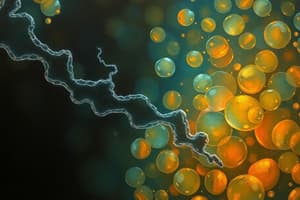Podcast
Questions and Answers
Which condition is characterized by abnormal protein accumulation in various organs and tissues?
Which condition is characterized by abnormal protein accumulation in various organs and tissues?
- Fatty liver disease
- Gout
- Amyloidosis (correct)
- Lipofuscin
What is the most common form of amyloidosis?
What is the most common form of amyloidosis?
- Fatty liver disease
- AL amyloidosis (correct)
- Hemochromatosis
- Gout
What gene mutation is associated with hereditary hemochromatosis?
What gene mutation is associated with hereditary hemochromatosis?
- Immunoglobulin light chain mutation
- Tfr2 gene mutation (correct)
- Transferrin receptor mutation
- Amyloid protein mutation
Excessive iron accumulation is a characteristic feature of which condition?
Excessive iron accumulation is a characteristic feature of which condition?
Which type of intracellular accumulation can lead to cellular degeneration and cell death?
Which type of intracellular accumulation can lead to cellular degeneration and cell death?
What is the main substance that accumulates in gout?
What is the main substance that accumulates in gout?
What is the composition of lipofuscin, an intracellular accumulation?
What is the composition of lipofuscin, an intracellular accumulation?
What is the main cause of alcoholic fatty liver disease?
What is the main cause of alcoholic fatty liver disease?
What organ can accumulate uric acid crystals in cases of visceral gout?
What organ can accumulate uric acid crystals in cases of visceral gout?
Which metabolic disorder is characterized by the accumulation of uric acid crystals?
Which metabolic disorder is characterized by the accumulation of uric acid crystals?
Which condition can lead to liver fibrosis and cirrhosis if not managed properly?
Which condition can lead to liver fibrosis and cirrhosis if not managed properly?
What type of cells are more prone to lipofuscin accumulation?
What type of cells are more prone to lipofuscin accumulation?
Flashcards are hidden until you start studying
Study Notes
Intracellular Accumulations: Understanding Amyloidosis, Hemochromatosis, Fatty Liver Disease, Gout, and Lipofuscin
Intracellular accumulations occur when cells accumulate endogenous by-products or exogenous substances due to metabolic abnormalities, genetic mutations, or exposure to indigestible exogenous substances. These accumulations can be relatively harmless or promote cellular degeneration and even lead to cell death. This article explores various types of intracellular accumulations and their associated conditions, including amyloidosis, hemochromatosis, fatty liver disease, gout, and lipofuscin.
Amyloidosis
Amyloidosis is a group of diseases in which an abnormal protein, called amyloid, accumulates in various organs and tissues. The most common form of amyloidosis is called AL (alpha-light chain) amyloidosis, which occurs when abnormal plasma cells secrete immunoglobulin light chains into the circulation. These light chain fragments can be deposited almost anywhere in the body, leading to various complications depending on the affected organ(s).
Hemochromatosis
Hemochromatosis is a condition characterized by excessive iron accumulation in various organs, including the liver. The disease can be hereditary or sporadic. Hereditary hemochromatosis is caused by mutations in the transferrin receptor 2 (Tfr2) gene, which decreases the expression of the transferrin receptor and leads to increased iron absorption. In sporadic cases, the cause is unknown, but it is often related to genetic or environmental factors.
Fatty Liver Disease
Fatty liver disease, also known as steatosis, occurs when lipids accumulate in liver cells, leading to liver damage and inflammation. There are two main types of fatty liver disease: alcoholic and non-alcoholic. Alcoholic fatty liver disease is caused by the excessive consumption of alcohol, while non-alcoholic fatty liver disease (NAFLD) is associated with conditions such as obesity, diabetes, and metabolic syndrome. In severe cases, fatty liver disease can progress to liver fibrosis and cirrhosis, leading to liver failure.
Gout
Gout is a metabolic disorder characterized by the accumulation of uric acid crystals in various organs, including the liver. Uric acid crystals can cause inflammation and tissue damage, leading to joint pain, swelling, and other complications. In cases of visceral gout, uric acid crystals accumulate in the liver, potentially causing liver damage and other health issues.
Lipofuscin
Lipofuscin is a type of intracellular accumulation that occurs when lysosomes, cellular organelles responsible for breaking down cellular waste, become overloaded and can no longer process cellular waste products. This leads to the accumulation of lipofuscin, which is composed of lipids and other cellular debris. Lipofuscin accumulation is more common in cells with limited regenerative capacity, such as neurons, and can contribute to their degeneration and loss.
In conclusion, intracellular accumulations are a diverse group of conditions that can lead to various health issues depending on the accumulated substance and the affected organ. Understanding these conditions and their underlying causes is crucial for the development of effective treatments and prevention strategies.
Studying That Suits You
Use AI to generate personalized quizzes and flashcards to suit your learning preferences.




